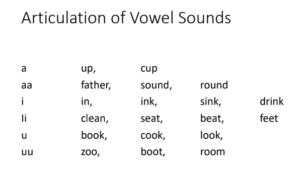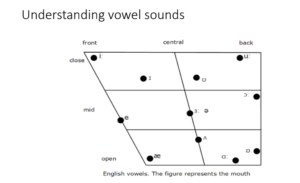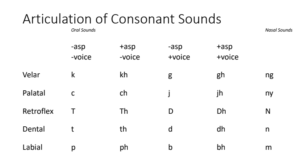sounds in english language
- the way we write english is different from the way we speak this is
- in the sense that we write english with the alphabet which has 26 letters those letters those writing symbols
do not completely capture the sounds of the language - so when we speak there are more number of sounds in spoken english than the characters in written symbols
- that is to say again the writing symbols are different from speech sounds
- there are 26 characters for writing symbols
- we know those symbols as english alphabet and
- they are used to write when we write a word we use those letters those characters to represent sounds
- however there are more number of sounds than
- the letters there are 26 letters but 44 sounds out of them 20 of them are vowel sounds and 24 of them are consonant sounds so
- as we know paying attention to these details and nuances of this sound system in return helps us
understand them in a better way - then when we use our understanding of these things in a better way we see the impact of that in our spoken
english and thus it makes us a confidentialist speaker - a confident speaker naturally sounds impressive
- these nuances of english sound system and also with the contrast from the way we speak the way we use
certain sounds from our languages in english
Vowel Sounds

- as we know in writing symbol we have five characters five letters to represent vowel sounds they are a e i
o and u these are the lowercase letters these are A E I O U as uppercase letters - but when we speak vowel sounds we do make a distinction in the following terms
- then we say ah we also say ah in english we also use e then we use long e e then we use oo and then we use long o
- Three pairs a,aa i,ii u,uu
- these three pairs can be contrasted in terms of long and short distinction in these three pairs
- first one is short the second one is long
- this short and long distinction is in terms of the duration of time that we take in producing these sounds so for one first one we take shorter duration for the second one we take longer duration
- without at least one vowel sound we do not have a word this is what it means when we say vowels are more fundamental for making a word that is vowel sounds are more fundamental for making a word
- This is true for all languages that is this is true for the languages that we speak such as hindi bangla marathi
gujarati punjabi or tamil telugu kannada or malayalam or any any any language that we speak - english is no exception to that so in the process of understanding sound systems in english
- for english language too we in in the words of english
- there must be at least one vowel no matter how small a word is there must be at least one vowel if there are bigger words then there could be more number of vowels
- It is also possible that there could be all vowels only but there must be at least one i think when we say a word like up the word like up as up and down
Sounds Of Vowels
- the first sound of this word is the first sound in the word up is as opposed to the first sound in the word father
- the first sound in the word father right after that the sound that follows is ah that’s a longer vowel a vowel sound and when we say father pay attention to the vowel first vowel ah you will see the distinction in terms of duration of the time so one is the short vowel the other is long vowel
- cup in this word the vowel is the second sound there are three sounds in this word
- second sound happens to be a vowel which is a shorter vowel than the second sound in a word like sound sound da second sound in this word is ah and that is longer than ah
- these two sets up shorter vowel father longer vowel cup shorter vowel sound longer vowel
- in a word like up the sound a is written with the symbol you again in the sound again in the word cup sound is written with symbol u in the word father sound ah that is long vowel is represented with a that is symbol a and in a word like sound the long vowel ah has completely different writing symbol that is o
- so this is the way we write this spelling of a word
- when we say k, a and p for a word like cup we have three sounds but they are written as c u p that was the distinction
- So english words are written using the writing symbols alphabet letters from alphabet but when we speak we use different sounds for that
- when we speak we speak properly we speak appropriately and we which in turn will make a sound impressive and confident
- another word round again in this one you see a second sound are being represented with some other symbol
- these slant lines and the letters inside the slant line the sounds of a word
- when writing about writing round you can say raaund so length you can represent by doubling of these letters sometimes they are also represented as putting a small line on top of that
- but for using it on a piece of paper or typing it on computer this is much easier
Distinction between short i and long ii
- in the words like in ink sink drink these are just some random examples of words in which we sign we find short e
- for instance however in a word in words like clean seat beat feet we see the the sound e is longer than the ones in the previous set of words
- when you write these these right sounds of each one of these words you will see the distinction
- words like up cup father sound round ink sink drink clean seat beat feet you will see the distinction
- The word like seat you can contrast it with an another example of a word like sit
- try saying these two words seat sit you will see there are only three sounds in both words sit seat
- the only distinction is the vowel in the first one is shorter i and vowel in the second one is longer ii and that makes the distinction in terms of the meaning of these two words so such a distinction is called phonemic
distinction
Phonemic Distinction
- if one small sound and one small distinction between two sounds make the distinction between the meaning
of the two words - that is the distinction we want to capture not only in similar sounding words but in most of the words
- so we should be able to say sit when we want to say say that and we should be able to say seat when we want to say that
- this distinction comes the understanding about this distinction comes when we know that there are vowels in english language which are some are shorter vowels some are longer vowels
Pressure On the Tongue
- when we say a the tongue in our oral cavity is little retracted.
- When we say i, ii, stress on the tongue is towards the middle side.
- nd when we say u, uu, we see rounding on our lips.
Difference between u an uu
- words like book, cook, look each one of them have three sounds like book, /bʊk/. Cook, /kʊk.
- Look /lʊk/. In each one of these words, the second sound is a vowel, but that is a shorter vowel.
- And when you say words like zoo, boot, room, we have longer vowel
- there is distinction in terms of long and short
- distinction in these three sets of vowels, i.e a aa ii u uu and it will give you a better understanding about vowels in English.
- These vowel distinctions that you see, these vowel distinctions are in the languages that we speak as well.
- These this type of distinction between a and aa, i and ii, u and uu this distinction is available In Hindi.
- This distinction is vailable in Punjabi, Bangla, anada, Tamil, Telugu any language that we speak these distinctions are available.
- So you should be able to find them, and when we speak English, we do speak these sounds as well, and we should be very confident about that about these sounds coming in English from us.
- These sounds are available in English too.
There are more vowels, as you know, 20 of them how do we know about it?

- this chart tells you about more vowels of English sound, and this will also give you an understanding of how ii is a front vowel.
- How i shorter i is slightly central, that is according to the tongue position.
- And u is a back vowel.
- But in terms of rounding, lip is rounded.
- So it is called closed vowel. So then, according to the tongue position, the distinction is front, central and back.
- And you can find most of the vowel-like aa.
- When we say aa, it is a back vowel towards the back. a and aa both towards the backside in the oral cavity, but they are open vowel.
- They are æ, a, /ɔ/; they are all mid vowel.
- So it is not open, not totally close, but they are mid vowels.
- But some are towards the back; some are towards the front.
- So this chart is basically the tongue position and opening and closing of the mouth.
- when we understand the vowels that are similar in our languages also, and they are places of articulation,
Articulation of consonants sounds

- When we use these vowels in different words, and when we pay attention to them, it becomes very important for us.
Facebook Comments Box